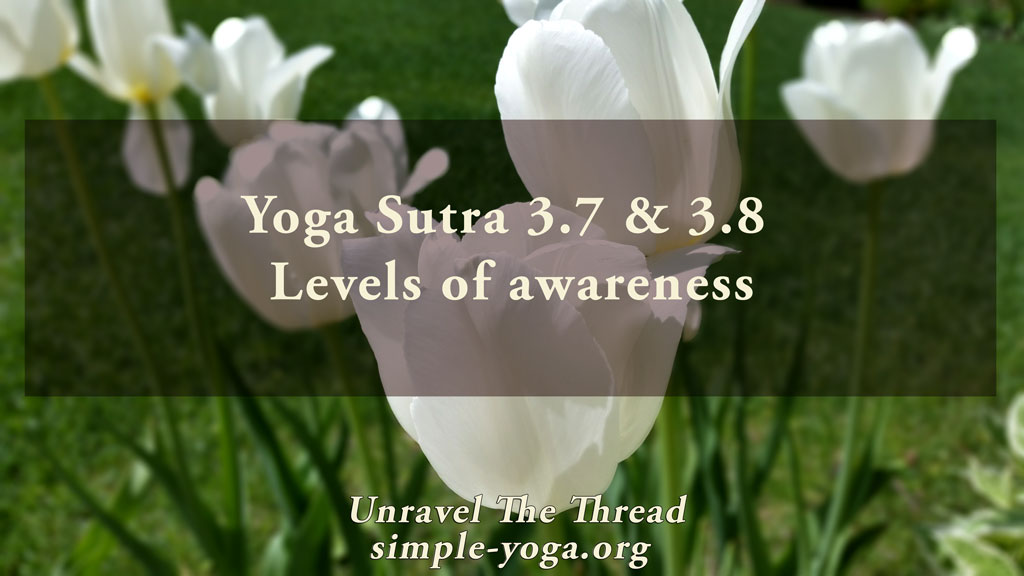
3.7 & 3.8 Levels of awareness
July 8, 2021
3.10 Inner Silence Expands
July 23, 2021
3.7 & 3.8 Levels of awareness
July 8, 2021
3.10 Inner Silence Expands
July 23, 20213.9 Towards inner silence

3.9 Increased tendency to inner stillness and away from outward attention. Growing inner awareness transforms the body, mind, and senses (nirodha parinama).
The practice of yoga is a journey to regulating our tendencies. The overall process can be understood as an application of sutras 1.39 and 2.33. The former aphorism invites you to focus on anything that inspires you, while the latter echoes that message, encouraging you to redirect your tendencies from unhelpful to uplifting (pratipaksha bhavana). The first seven limbs of yoga promote ways to remove inefficiencies and to establish tendencies conducive to living in harmony with yourself and the world. As a result, all your different aspects articulate together seamlessly. In this sutra the word parinama indicates change or transformation. At this stage of the practice, all emotional, physical, respiratory, and mental obstacles have been removed, and the practice transforms the body, mind, and senses so that instead of being at the mercy of innumerable distracting tendencies pulling you away from presence, you now gravitate towards embodied awareness. Instead of entertaining yourself with irrelevant internal chatter, you align effortlessly with your inner stillness and silence. That inner stillness is the result of the suppression, restraint, or control (nirodha) of the wayward ways of being. Hence, this stage of the process is called nirodha parinama, the transformation of your inner world because of the practices that control, restrain and eventually remove your unhelpful ways.
Current science seems to confirm what early yogis learned through using their bodies and minds as a laboratory of inner exploration. Recent research indicates that regular meditation practice seems to cause physical and physiological changes to the brain. These changes appear to contribute to enhanced performance in processing information, making decisions, forming memories, and improving attention, as well as enabling improved learning and emotional regulation, reduction of fear, anxiety and stress, increase in positive emotions, emotional stability, and mindful behavior. Some other changes include enhanced capacity to choose between automatic habits and thoughts and meaningful choices as well as deep feelings of well-being and oneness. As you practice with patient persistence, notice if there is a change in your attitude, mood, distractedness and overall experience. Are you currently complaining more or less than before? Are you more willing to participate in all aspects of your life with kindness and compassion?
As usual, one more way of exploring the meaning of this sutra is by chanting it.
You can choose to chant it in its traditional form with some of the words coming together:
3.9 vyutthānanirodhasaṃskārayoḥ abhibhavaprādurbhāvau nirodhakṣaṇa cittānvayo nirodhapariṇāmaḥ
व्युत्थाननिरोधसंस्कारयोः अभिभवप्रादुर्भावौ निरोधक्षण चित्तान्वयो निरोधपरिणामः ॥९॥
Another option is to chant each word in the sutra individually:
- vyutthāna
- nirodha
- saṃskārayoḥ
- abhibhava
- prādurbhāvau
- nirodha
- kṣaṇa
- citta
- anvayaḥ
- nirodha
- pariṇāmaḥ
If you prefer, you may listen to the podcast:
Unravel the thread is now available as a book!
If you find Simple-Yoga.org and Unravel the thread useful, consider supporting my labor with a donation, you may also donate using PayPal or Venmo. Thank you!
